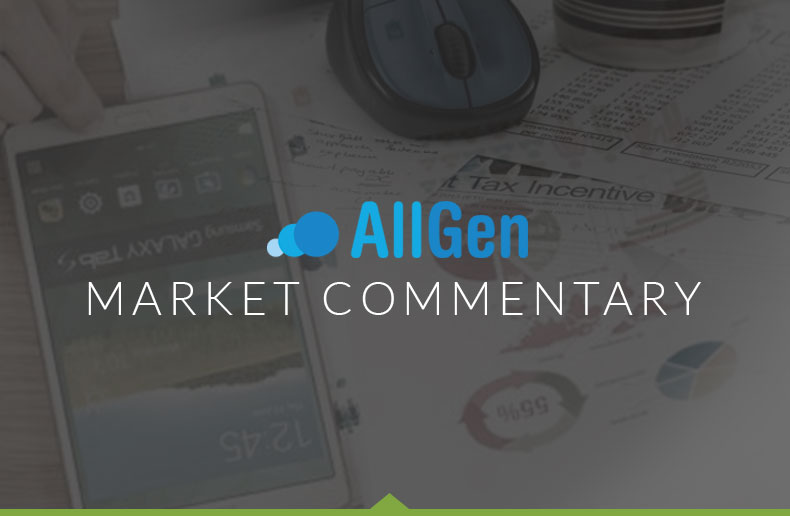1st Qtr Review
The year started off in the red after such a positive 2013. The combination of investors coming to the realization that the FED stimulus measures are coming to an end and Unrest in Ukraine was enough to reverse some of the gains of 2013. However, after the market dropped nearly 6% to start the quarter it roared back to end the quarter slightly positive. Continuing with a similar theme as last year U.S. stocks lead over international stocks. On the other hand after such a bad 2013 bonds started the year tied with the S&P 500 to lead the major indices higher. In this issue of Allgen’s quarterly market commentary we will look at the historical trends of midterm election years, the uptrend in capital spending and as always we will give you an update to the bond market.
Historical Trends in the 2nd Year of a Presidential Cycle
Going back to 1962 there been a very interesting trend that has occurred every midterm election year (See chart below). Every midterm election year since 1962 the market has had a correction, on average just under 19%. Those corrections usually occurred close to the summer months. But, the fascinating trend is that the twelve months following the point at which the correction ended had a sizable gain, on average 32%. Currently our portfolios are positioned somewhat conservative compared to their averages. If this trend repeats this midterm election year we will try to take advantage by reposition after the correction in the attempt to capitalize on the ensuing bounce assuming this trend continues.
Source of Chart: Strategas Research Partners LLC.Source: https://www.schwab.com/ Uptrend in Capital Spending (CAPEX) Cycle
Let’s first start by understanding the lingo – The Definition of ‘Capital Expenditure – CAPEX’ (as per investopida.com) – Funds used by a company to acquire or upgrade physical assets such as property, industrial buildings or equipment. This type of outlay is made by companies to maintain or increase the scope of their operations. These expenditures can include everything from repairing a roof to building a brand new factory.
Now that we understand what CAPEX is let’s look at what an uptrend in capital spending would mean to the economy. Over the last few years there has been a tilt by activist investors that has favored companies using their funds to buy back their own company stock and payout dividends rather than use that money to invest in improving their machinery, building or improving manufacturing plants or upgrading technology. While buybacks and dividends continue to increase, quietly at the end of last year CAPEX spending reached an all-time high. Reaching new highs in itself doesn’t necessarily mean that the trend will continue, but add on top of recent momentum, the fact that companies have a ton of cash on hand and the probability of the upward trend of CAPEX spending is high. Statistics show that liquid assets at nonfinancial companies is at the highest point since World War II. Why does this matter? When companies buy new machinery, build/improve manufacturing plants or upgrade technology it helps the economy grow. We believe industrial and technology companies will benefit most from this trend.
Bond Market Update
After a bad 2013 for bonds in which the Barclays Aggregate Bond Index was down just over 2% for the year, bonds started off the year up nearly 2%. As we reported in our in our last couple market commentaries we believe we are starting a long-term upward trending interest rate cycle. We’ve positioned our bond portfolios accordingly. We believe a bond portfolio consisting of a core segment of investment-grade intermediate to short term (Government, Corporate, Agency and Muni) bonds along with a satellite piece of short term to intermediate High Yield bonds with a slice of international and emerging market bonds is the best approach in the first few years of an upward trending interest rate environment. Going forward we believe interest rates won’t go up at the pace they went up last year, but we also believe long term total returns for bonds will be much lower than what we experienced over the last 30 years.
Going Forward
We believe if the historical midterm election year correction trend repeats itself this year then we will have an excellent opportunity to convert some conservative assets into positions that could appreciate at a faster rate on a rebound. While we believe a correction in the stock market may occur in the summer or prior to the mid-term election we would view a pullback in the market as a buying opportunity for stocks. Specifically we would look to increase our mid and small cap U.S. positions with a focus on industrial and technology stocks to take advantage of the increase in capital spending that should continue. While stocks provide growth potential, bonds play a significant role in protecting capital, reducing volatility and providing income. On the bond side we believe a bond portfolio consisting of a core segment of investment-grade intermediate to short term (Government, Corporate, Agency and Muni) bonds along with a satellite portion of short term to intermediate High Yield bonds with a small amount of international and emerging market bonds is the best approach in the first few years of an upward trending interest rate environment. We continue to manage risk first in all of our investments, while also seeking to outpace our clients’ appropriate benchmark over the long-term net of our fees.





